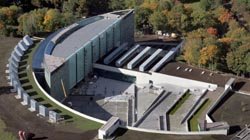
Estonia has just marked its annual Victory Day, the anniversary of the victory of Estonian forces against the invading German army of General von der Goltz in 1919, and the subsequent defeat of the twin invading forces of Germany and the Soviet Union, which led to the signing of the Tartu Peace Treaty between Estonia and the Soviet Union in 1920.
Now the Finland-Swedish daily newspaper Hufvudstadbladet writes about Kumu, a new museum of Estonian art. Kumu ("Resonance"), in Estonia's capital city, Tallinn, is designed by a Finnish architect, Pekka Vapaavuori. The newspaper notes that while after the Second World War Finnish artists looked towards the future, their Estonian colleagues chose to do the opposite and look back - to the period before the Soviet occupation when Estonian artists took part in the mainstream of the currents of cubism and modernism in Europe. "We clung firmly to the idea that we were Europeans," says Sirje Helme, director of the new museum.
There are two main exhibits, set to run until 2008 - one, called "Treasury", shows Estonian art from the 18th century until the outbreak of the Second World War, while the other, called "Difficult Choices", presents Estonian art from the end of the war until the restoration of the country's independence in 1991. The second exhibit contains some works which have Soviet repression as their theme, and have not been seen in public before.
The museum is partly built into the rock of the surrounding landscape, and is thus much larger than it looks. A third exhibit, "Different Modernism, Different Avant-garde", focusing on the most recent Estonian art, is due to open in 2007.
No comments:
Post a Comment